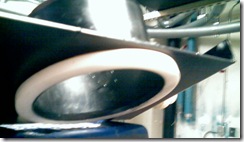In frustration, I turned to the healthier parts of the system. I learned that:
- There are several different ways to construct a diverter - it seemed that each one was put together in a manner different from the last 3 I had looked at. I am going to assume that it's because diverters are set up differently - horizontal tubes, vertical tubes, etc - and not that we were just the victim of using whatever happened to be on the truck, that day. It didn't really matter now, except that each solution would be different.
- In my well-working zones, there wasn't a whole lot of difference in pressure/suction between the stations closest to the APU's (Air Power Units - blowers) and those at the farthest end. This meant that it was possible to realistically expect this - not to assume that the end stations were just going to be weak.
- The two zones I had problems with, those stations had the largest number of diverters between them and the APU's. More opportunities for leakage. Sure, it makes sense now, but I was learning this on my own.
- Suction was the first indicator of a problem, because of inertia. When pressure is applied to the tube, it's only about 20 feet from the APU. Gets the kick in the pants and off it goes. If the pressure's weakening as it gets to the outer limits of the system, gravity and inertia tend to carry it along. With suction, it's the opposite. The closest analogy I've thought of is holding a rubber band between your two hands. The farther you pull your hands apart, the more force it takes. That, of course is kinetic energy pulling your hands back together, but the point is that that energy has to be transmitted the entire length of the tube to have an effect on that carrier sitting out in the open atmosphere in an arm to be pulled into the tube in the first place. The reverse effect. Did I mention that I have a degree in psychology? Thank you.
Fascinated? I know I am. Let's continue.
One example , then we'll move on. Here's one end of one diverter. The white plastic ring is what would slide on the metal wall of the box from one path to the other. The other end would be connected to a section of metal tube with a rubber sleeve, flexible enough to accommodate the movement. At the other end, another sleeve to the one opening at the other end. Now, let's take a closer look, shall we?
, then we'll move on. Here's one end of one diverter. The white plastic ring is what would slide on the metal wall of the box from one path to the other. The other end would be connected to a section of metal tube with a rubber sleeve, flexible enough to accommodate the movement. At the other end, another sleeve to the one opening at the other end. Now, let's take a closer look, shall we?
I would draw your attention to the brown thing between the white ring and the metal. That's a rubber ring, yes it is. It's actually tubing that's wedged in there, with the ends glued together to make a ring. Now, this is one of the things that I really didn't see until someone pointed it out to me - remember that these boxes are wedged up in the ceiling between conduits, steam lines, gas lines of various persuasions, etc. - and this is only one configuration. Some of these details, one can only find by feel or shutting it down and dismantling them. It was time, though.
There was no huge leak. They were all over. It became a matter of methodically working through the diverters, and the suction increased gradually until we were peggin' the meter everywhere.
The lessons learned were these:
- The system was more complex (and better designed) than I originally thought it was.
- Because of this, my expectations of what it could do needed to change.
- Once my predecessor finally started to get more detailed, this included admitting to a certain lack of maintenance and, shall we say, follow-through on his and others' parts. Aye, there's the rub! Now the college boy was making him look bad. Guess what, the system was doing that, not me.
So, I'm smarter, it's better, and I've gained a certain confidence in an area I never wanted to know better. I'm proud of the work ethic that's been instilled in me by those who chose to invest, as well as my own stubbornness and ability to work through really being pissed off. Sad to say, I'm surrounded by a working atmosphere where, when the work's not obvious, people take shortcuts and would rather put some tape on something that really needs to be replaced. Most of this system is hidden; I have literally pulled 3-4 layers of tape off certain places. It is also sad that our current working environment does not lend itself readily to mentoring, apprenticeship, the passing down of the values behind the processes, the true nature of quality that starts with the person holding the tools, doing the right thing, making those pieces shine that no one else would ever see. It was this realization that turned my anger into action, and then into pride of accomplishment. I learned what it would take to make this work like it should, and then did it. It's why I've gone on so long about it. Nobody else really cares, beyond it's working or not, but I know better. I'm not proud about a lot of things; you won't hear me talk like this, very often (at least I hope not). It has been something of a journey for me, this tube system.
